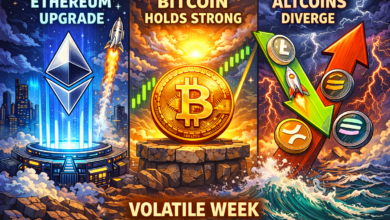Without Bitcoin, what happens to Ether and XRP?
The Unlikely Scenario: A Market Without Bitcoin
Imagine waking up one day to a cryptocurrency market that no longer includes Bitcoin. Whether it’s due to sweeping regulatory crackdowns, a devastating technical failure, or a sudden institutional pivot, the unthinkable becomes reality—Bitcoin is gone. Its disappearance would undoubtedly throw global crypto markets into immediate disarray. Panic would ripple through trading platforms, liquidity would evaporate, and investor confidence would momentarily shatter. However, in the midst of this chaos lies opportunity—particularly for investors who have always looked beyond Bitcoin’s dominance and toward the underlying potential of other digital assets.
Bitcoin has long been the gravitational center of the crypto universe, anchoring portfolios and dictating market sentiment with every price movement. Its role as “digital gold” has largely colored how the broader market is perceived. But without Bitcoin, altcoins would no longer be just alternatives—they would be the market. Concepts of value and utility in crypto would need recalibrating, and in such a reshaped environment, Ethereum (ETH) and Ripple’s XRP would likely emerge as the new titans leading this decentralization revolution.
Ethereum: Stepping Into the Spotlight
Ethereum has always been second-in-command in the public eye, frequently trailing Bitcoin in price trends and institutional preference. ETH’s movements are historically correlated with BTC, making it difficult for casual investors to differentiate between the two. However, Ethereum’s true value lies not in mimicking Bitcoin’s behavior but in offering something fundamentally different: infrastructure. Ethereum is the nerve center of the decentralized internet—a Layer-1 blockchain that supports smart contracts, decentralized applications (dApps), decentralized finance (DeFi), non-fungible tokens (NFTs), and countless community-driven innovations.
Removing Bitcoin from the equation would force institutional and retail market participants to reassess Ethereum on its own merits. With substantial upgrades such as the Merge (which transitioned the network from proof-of-work to proof-of-stake), EIP-1559 (which introduced a deflationary burn mechanism), and continued scaling developments through Layer-2 solutions like Optimism and Arbitrum, Ethereum is technically and structurally positioned for long-term sustainability and growth.
Beyond its technical capabilities, Ethereum also thrives from one of the largest and most active developer ecosystems in the blockchain space. Thousands of developers are dedicated to enhancing its functionality, reducing congestion, and improving throughput. The network doesn’t just serve transactions—it powers an entire decentralized economy. DeFi alone represents billions of dollars in Total Value Locked (TVL), and the NFT and DAO sectors continue to expand in both innovation and adoption.
In a Bitcoin-less world, Ethereum could become the new standard, not just as a leading digital asset but as the digital infrastructure layer for the Web3 future. Institutional capital, which has historically allocated toward Bitcoin for its perceived stability, would now look at Ethereum’s utility and sustainability. ETH’s blend of technological merit and financial utility gives it the credibility to lead the market forward into a new phase of tokenized networks and decentralized infrastructure.
XRP: The Institutional Underdog
Ripple’s XRP has often been the subject of polarizing debate in crypto circles. Between ongoing legal battles with the U.S. Securities and Exchange Commission (SEC) and criticism over its degree of centralization, the asset has faced significant scrutiny. Yet despite these challenges, XRP has maintained strong relevance in global financial systems, particularly in the cross-border payment sector. Underneath the controversy lies a robust network of partnerships with central banks, remittance operators, and financial institutions.
Unlike Ethereum’s decentralized development ethos, Ripple operates with a more centralized model, which has helped facilitate negotiations and collaborations with traditional financial entities. XRP’s greatest strength lies in its utility as a bridge asset, designed to quickly and cost-effectively facilitate fiat-to-crypto and cross-border transactions. With settlement speeds of around 3–5 seconds and extremely low transaction fees, XRP is uniquely positioned to meet the needs of a digitized financial infrastructure.
In the absence of Bitcoin, XRP could see renewed adoption, particularly among institutions seeking efficient ways to manage cross-border liquidity and settlement systems. With BTC no longer monopolizing media attention, liquidity, and investor interest, the door opens for XRP to reshape its public image—from a “centralized banker coin” to a practical solution for real-world financial problems.
While retail sentiment has historically tilted against XRP due to decentralization concerns, institutional players remain intrigued by its scalability and cost-effectiveness. The asset’s ledger can handle up to 1,500 transactions per second, making it one of the fastest blockchain networks in existence. Further, Ripple’s upcoming solutions like Liquidity Hub and Central Bank Digital Currency (CBDC) platforms continue to gain traction. In such a scenario, XRP’s adoption curve could inflect significantly higher in the absence of Bitcoin, giving it a viable path to market leadership.
The Contrarian Portfolio: A New Investment Paradigm
Conventional crypto portfolios have long been built around Bitcoin as the core investment, owing to its stability, brand recognition, and liquidity. Its role as “digital gold” turned BTC into a household name, a safe bet for institutional gatekeepers. But if Bitcoin disappears, portfolio managers and retail investors alike would be forced to reimagine their allocation strategies. Without its gravitational pull, altcoins would assume center stage in diversified crypto holdings.
Here’s a hypothetical contrarian portfolio designed for a post-Bitcoin era:
- 50% Ethereum (ETH) – Poised to become the foundational blockchain layer of the internet economy. With increasing utility across DeFi, NFTs, staking, gaming, and enterprise adoption, ETH becomes the go-to Layer-1 investment.
- 25% XRP – Emerging as the financial plumbing of the next-generation payment rail system. XRP’s bridging capability makes it critical for interoperability between crypto assets and national currencies.
- 15% Layer-2 and Scaling Tokens – Projects like Arbitrum (ARB), Optimism (OP), and StarkNet offer critical infrastructure to scale Ethereum’s throughput without compromising security or decentralization.
- 10% Frontier Innovation Tokens – Allocations here could include decentralized artificial intelligence platforms like Fetch.ai (FET), decentralized storage solutions like Filecoin (FIL), or oracle networks such as Chainlink (LINK). These tokens represent asymmetrical upside potential in uncharted technological territories.
Such a portfolio reflects a paradigm shift: away from Bitcoin’s narrative of scarcity and toward real-world utility, ecosystem interoperability, and community-driven innovation. In this new world, value resides in applications, infrastructure, and adoption—not in mere digital hoarding.
Final Thoughts: The Market Moves Forward
Should Bitcoin ever exit the stage, it would undoubtedly mark a seismic shift in the digital asset space. For years, Bitcoin has served as the psychological and financial benchmark for the entire cryptocurrency industry. Its absence would leave a void—a vacuum of sentiment, liquidity, and structure. But from that void, a new crypto hierarchy would emerge, centered not on scarcity but on utility, scalability, and real-world integration.
Ethereum and XRP—each with their contrasting philosophies and use cases—are well-positioned to capitalize on this transition. Ethereum offers the infrastructure backbone essential to building decentralized ecosystems, while XRP provides the tools necessary to bridge traditional finance with blockchain technology. Together, they represent the leading edge of a diversified, function-first crypto economy that could thrive in a post-Bitcoin world.
For forward-thinking investors, the potential fall of Bitcoin isn’t the end of crypto—it’s the beginning of decentralization 2.0. As the dust settles, smart capital will move swiftly toward new leaders. The throne is vacant, and the race for the next crypto king is already underway.
Source link





